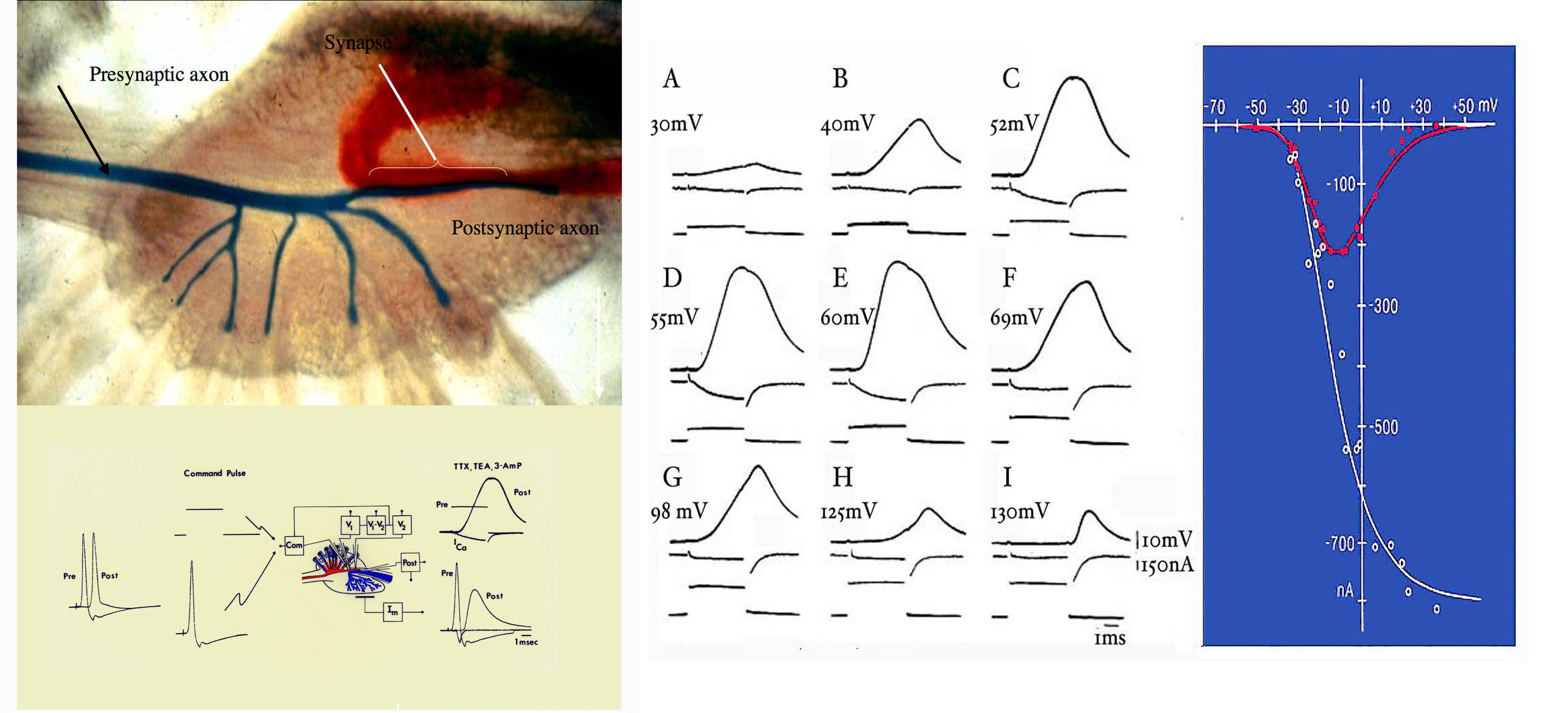- Squid giant synapse
The squid Giant Synapse
Anatomy
This chemical synaptic junction was first recognized by
John Zachary Young in 1939.Thesquid giantsynapse (Fig 1) is the largest chemical junction in nature. It lies in the stellateganglion on each side of the midline at the posterior wall of the squid’s muscular mantel. Activation of this synapse triggers the synchronous contraction of the mantle musculature that is responsible for the forceful ejection of a jet stream of water from the mantle. This water propulsion allows the squid to move rapidly through the water and even to jump through the surface of the water (breaking the air water barrier) to escape predators.The information to the mantle is transmitted via a chain consisting of three giantneurons organized in sequence. The first is located in the ventral magnocellular lobe, central to the eyes. It serves as a central integrating manifold that receives allsensory systems and consists of two symmetrical neurons (I). They, in turn, contact secondary neurons (one in each side) in the dorsal magnocellular lobe and (II) and in turn contact the tertiary giant axons in the stellate ganglion (III, one in each side of the mantle). These latter are the giant axons that the work ofAlan Hodgkin andAndrew Huxley made famous.Each secondary axon branches at the stellate ganglion and contacts all the tertiaryaxons .Information concerning relevant sensory input is thus relay from the sense organs in the cephalic ganglion (the squid’s brain) to the contractile muscular mantle activated directly by the tertiary giant axons.Electrophysiology
Many essential elements of how all chemical synapses function were first discovered by studying the squid giant synapse. Early electrophysiological studies demonstrated the chemical nature of transmission at this synapse by making simultaneous intracellular recording from the presynaptic and postsynaptic terminals in vitro (
Theodore Holmes Bullock and Hagiwara (1957), Hagiwara andIchiji Tasaki (1958), Takeuchi and Takeuchi (1962). Classical experiments later on demonstrated that, in the absence of action potentials, transmission could occur (Bloedel et al (1966), Katz and Miledi (1967), Kusano et al (1967). Thecalcium hypothesis for synaptic transmission was directly demonstrated in this synapse by showing that at theequilibrium potential for calcium (+60 mV, calcium does not enter the presynaptic terminal) no transmitter is released (Bernard Katz and R. Miledi 1967). Thus, calcium entry and not the change in the transmembrane electric field is responsible forvoltage clamp studies that determined the relationship between the time course and amplitude of the calcium current and the amount of transmitter release directly determined (Llinas et al 1981, Augustine et al 1985) This preparation continues to be the most useful for the study of the molecular and cell biological basis for transmitter release. Other important new mammalian preparations are not available for such studies such as theCalyx of held .
1000px|thumb|center|">Fig 2. Upper leftReferences
* Young J.Z. (1939) “Fused neurons and synaptic contacts in the giant nerve fibers of cephalopods” Phil. Trans. Roy. Soc 229:465-503
*Bullock TH and Hagiwara S. (1963) “Intracellular recording from the giant synapse of the squid” J. Gen. Physiol. 40:565-577
* Hagiwara S. and Tasaki I. (1958) “A study on the mechanism of impulse transmission across the giant synapse of the squid “ J. Physiol.. 143:114-137
* Takeuchi A, and Takeuchi N. (1962) “Electrical changes in the pre and postsynaptic axons of the giant synapse of Loligo” J. Gen Physiol. 45:1181-1193
* Bloedel JR., Gage,PWQ., Llinas R. and Quastel DMJ. (1966)“Transmitter release at the squid giant synapse in the presence of tetrodotoxin” Nature, 212:49-50
* Katz B and Miledi R.(1967) “A study of synaptic transmission in the absence of nerve impulses” J.Physiol 192:407-436
* Kusano K. Livengood, DR and Werman R. (1967) “ Correlation of transmitter release with membrane properties of the presynaptic fiber of the squid giant synapse” J. Gen. Physiol 50:2579-2601
* Llinas R, Steinberg IZ. and Walton K. (1976) “Presynaptic calcium currents and their relation to synaptic transmission. Voltage clamp study in the squid giant synapse and theoretical model for the calcium gate”PNAS 73:2918-2922
* Llinas R, Steinberg IZ. and Walton K.(1981) (a) “Presynaptic calcium currents in the squid giant synapse. Biophys J. 33: 289-321
* Llinas R, Steinberg IZ. and Walton K.(1981) (b) “Relationship between presynaptic calcium current and postsynaptic potential in squid giant synapse” Biophys J. 33: 323-352.
* Augustine GJ, Charlton MP, Smith SJ (1985) “ Calcium entry into voltage clamped presynaptic terminals of squid” J.Physiol 367:163-181
* Llinas R. (1999) “The squid Giant Synapse” Oxford U. Press•
Wikimedia Foundation. 2010.


_Simultaneous_intracellular_recording_from_the_presynaptic_fiber_(pre)_and_the_postsynaptic_axon_(post)._The_synaptic_action_potential_releases_a_transmitter_substance_(glutamate)_that_acts_on_the_postsynaptic_receptors_and_activates_the_postsynaptic_action_potential._B_&_C)_Synaptic_transmission_can_be_evoked_with_either_a_square_voltage_pulse_(B)_or_an_artificial_action_potential_wave_form_(C)_these_are_delivered_to_a_command_amplifier_as_shown_in_D._D._Diagram_of_a_command_amplifier_(CO)_and_current_injection_amplifier_(I)_with_a_feedback_control_via_presynaptic_voltage_(Pre_V)._The_response_to_these_stimuli_is_recorded_as_a_current_(Im)_and_displayed_in_green_in_E_and_F._E)_Synaptic_transmission_and_calcium_current_(ICa,_green)_evoked_by_a_square_voltage_pulse_(Pre)._F)_Calcium_current_(green)_and_postsynaptic_potential_(Post)_evoked_by_an_artificial_action_potential_(Pre)._Note_that_in_F_the_calcium_curren_starts_during_the_down_swing_of_the_presynaptic_action_potential._(modified_from_Llinas_1999)Middle_Image:_Left,_Voltage_clamp_records_illustrating_the_relation_between_transmembrane_voltage_in_mV_(square_wave_at_the_bottom_of_each_record)_Calcium_current_amplitude_in_nA_(middle_record)_and_postsynaptic_potential_in_mV._Time_mark_one_ms._The_voltage_steps_are_generates_from_a_holding_potential_of_-170mV._(Llinas_et_al_1981).Right_image:_Relation_between_voltage_and_current_for_the_“on”_(red_plot)_and_“tail”_(white_plot)_calcium_current._Voltage_in_mV_current_in_nA._(modified_from_Llinas_1999))